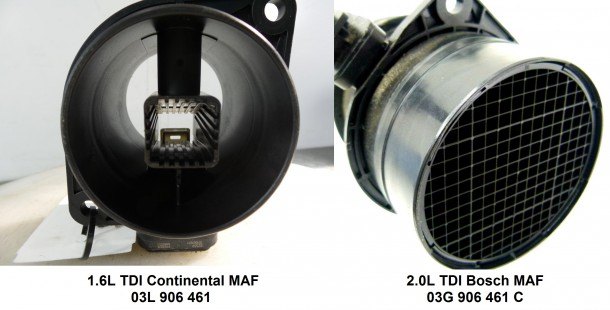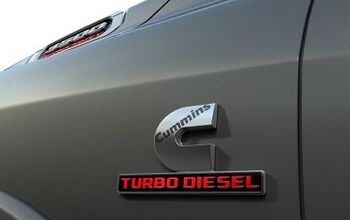How The Volkswagen Dirty Diesel 'Flow Straightener' Really Works

Volkswagen announced a fix for some of its diesel engines in Europe last week that included fitting a “flow straightener” device to their 1.6-liter engines. The device provides something tangible for Volkswagen to trot out, but has been criticized for being a low-tech distraction from the actual fix.
The “flow transformer” serves a purpose to provide a more accurate reading by the mass air flow sensor, but its initial exclusion may point to how far the cheating reached. To understand the implications of installing such a device, we need to take a look at the role of the mass air flow sensor on fuel and emissions mapping.
In a gasoline engine, the mass air flow sensor plays an integral role in calculating the fuel mixture for an engine and many of these sensors come with some sort of screen or grid in order to smooth out the air flow. The smoothed air flow allows for a more exact calculation of fuel, which can improve performance and fuel economy. It works so well that many even add them to large aftermarket intakes in order to achieve a better tune for theirs cars.
Diesel engines that deploy a mass air flow sensor do not use them for fueling calculations and instead they deploy the sensor as part of the EGR control strategy. The primary purpose of an EGR control strategy is to reduce nitrogen oxide emissions and the mass air flow sensor plays a role in calculating the EGR flow rate.
The telling part of excluding the “flow transformer” in the initial design is that multiple design teams would have been affected and would have to work around the limitation. The engineers that worked on the EGR system would have to calculate EGR flow based on their testing equipment and set it to a minimal level for production since real-time data would not be reliable enough to calculate it on the fly.
Without a reliable reading, the engineers may not have had enough data to create a functional EGR flow map and would need to let the car leave production with a dirty map. The preset EGR flow rate may work to clean up some of the emissions but it may not be optimal to meet all of the government standards hence the need for a “defeat device” map which could temporarily increase flow in order to pass the test.
While the “flow straightener” has been criticized by some as just a gimmick, it will actually serve a purpose, but the main driving force behind the fix is the programming. The device will assist programming the ECM with a proper EGR flow map that will reduce emissions and should meet the government standards in Europe.
Since the fix seems so simple now, many will ask why it was not installed and programmed on the cars when it was originally built and the answer lies in engine reliability. Increased EGR flow can cause increases in soot build up along with the need for increased maintenance on an engine. It can also cause premature failures on some engine components which could lead bean-counters to push for modifications in order to decrease the amount of warranty claims.
The 2-liter TDI engine is excluded from the “flow straightener” upgrade and for good reason. Taking a look at the sensor used on the engines, we can see an example of the 1.6-liter sensor made by Continental exposed the sensor element directly to the air stream, while the 2-liter sensor made by Bosch has a “flow straightener” screen built directly into the sensor thus negating the need to add one. All of the U.S. market diesels appear to use the Bosch sensor so the “flow straightener” is unlikely to make it to our shores as part of the upcoming recall fix.

More by Bozi Tatarevic
Latest Car Reviews
Read moreLatest Product Reviews
Read moreRecent Comments
- SCE to AUX All that lift makes for an easy rollover of your $70k truck.
- SCE to AUX My son cross-shopped the RAV4 and Model Y, then bought the Y. To their surprise, they hated the RAV4.
- SCE to AUX I'm already driving the cheap EV (19 Ioniq EV).$30k MSRP in late 2018, $23k after subsidy at lease (no tax hassle)$549/year insurance$40 in electricity to drive 1000 miles/month66k miles, no range lossAffordable 16" tiresVirtually no maintenance expensesHyundai (for example) has dramatically cut prices on their EVs, so you can get a 361-mile Ioniq 6 in the high 30s right now.But ask me if I'd go to the Subaru brand if one was affordable, and the answer is no.
- David Murilee Martin, These Toyota Vans were absolute garbage. As the labor even basic service cost 400% as much as servicing a VW Vanagon or American minivan. A skilled Toyota tech would take about 2.5 hours just to change the air cleaner. Also they also broke often, as they overheated and warped the engine and boiled the automatic transmission...
- Marcr My wife and I mostly work from home (or use public transit), the kid is grown, and we no longer do road trips of more than 150 miles or so. Our one car mostly gets used for local errands and the occasional airport pickup. The first non-Tesla, non-Mini, non-Fiat, non-Kia/Hyundai, non-GM (I do have my biases) small fun-to-drive hatchback EV with 200+ mile range, instrument display behind the wheel where it belongs and actual knobs for oft-used functions for under $35K will get our money. What we really want is a proper 21st century equivalent of the original Honda Civic. The Volvo EX30 is close and may end up being the compromise choice.



































Comments
Join the conversation
I don't argue the explanation about what a flow straightener does to a MAF and how that affects a diesel engine tune. That is all correct. But that piece of plastic is a minor red herring at best, in terms of what is needed to bring the affected TDIs into compliance. "Since the fix seems so simple now ..." There are two assumptions behind this simple statement that are unwarranted: 1- that the fix will reduce emissions below limits -- how about we wait for some real-world emissions results first, and also see how performance and longevity of parts are affected? 2- that the fix is largely a simple device like the flow straightener. The fix for the emissions starts and ends with changing the tune to increase duty cycle of EGR and a whole lot more. If in the process, they need to add a flow straightener to that 1.6 engine to get more reliable air mass readings, that is a significantly minor extra on all they have to do for a fix. Seriously, why are we focusing on that piece of plastic as somehow significant? You want more proof of why the flow straightener is largely insignificant? Why hasn't VW announced a fix for the 2.0 yet?
I know people who modify their MAF/MAS sensors and remove these screens. DSMs, GMs, Kompressors, BMWs, for example. Claims of increased throttle response and horsepower gains are always reported with ill affects noticed only at idle. Interesting. Makes sense, turbulent air is being forced to straighten its direction, there must be some loss? Anyway, how long before said screens destroy turbocharger compressor wheels? :-)